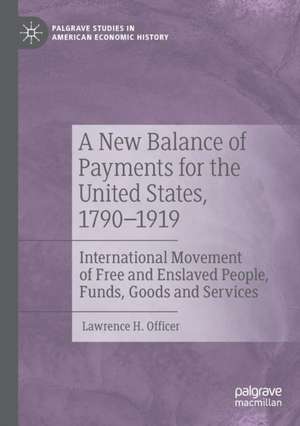A New Balance of Payments for the United States, 1790–1919: International Movement of Free and Enslaved People, Funds, Goods and Services: Palgrave Studies in American Economic History
Autor Lawrence H. Officeren Limba Engleză Paperback – 29 mar 2022
| Toate formatele și edițiile | Preț | Express |
|---|---|---|
| Paperback (1) | 730.79 lei 6-8 săpt. | |
| Springer International Publishing – 29 mar 2022 | 730.79 lei 6-8 săpt. | |
| Hardback (1) | 736.16 lei 6-8 săpt. | |
| Springer International Publishing – 25 mar 2021 | 736.16 lei 6-8 săpt. |
Preț: 730.79 lei
Preț vechi: 891.21 lei
-18% Nou
Puncte Express: 1096
Preț estimativ în valută:
139.84€ • 149.53$ • 116.59£
139.84€ • 149.53$ • 116.59£
Carte tipărită la comandă
Livrare economică 17 aprilie-01 mai
Preluare comenzi: 021 569.72.76
Specificații
ISBN-13: 9783030661014
ISBN-10: 3030661016
Ilustrații: XXXIII, 415 p. 1 illus.
Dimensiuni: 148 x 210 mm
Greutate: 0.54 kg
Ediția:1st ed. 2021
Editura: Springer International Publishing
Colecția Palgrave Macmillan
Seria Palgrave Studies in American Economic History
Locul publicării:Cham, Switzerland
ISBN-10: 3030661016
Ilustrații: XXXIII, 415 p. 1 illus.
Dimensiuni: 148 x 210 mm
Greutate: 0.54 kg
Ediția:1st ed. 2021
Editura: Springer International Publishing
Colecția Palgrave Macmillan
Seria Palgrave Studies in American Economic History
Locul publicării:Cham, Switzerland
Cuprins
Part I. WHY A NEW BALANCE OF PAYMENTS.- Chapter 1. Existing Historical Balance of Payments: A Survey.- Chapter 2. New Balance of Payments: Features and Implications.- Part II. MOVEMENT OF PEOPLE.- Chapter 3. Free People: Oceanic and Overland.- Chapter 4. Slaves: Oceanic.- Chapter 5. Passengers: Domestic.- Part III. MOVEMENT OF GOODS.- Chapter 6. Merchandise Exports.- Chapter 7. Merchandise Imports.- Chapter 8. Gold and Silver.- Chapter 9. Ships and Slaves.- Part IV. MOVEMENT OF FUNDS.- Chapter 10. Unilateral Transfers.- Chapter 11. Capital.- Chapter 12. Income.- Part V. PROVISION OF SERVICES.- Chapter 13. Transportation.- Chapter 14. Travel.- Chapter 15. Fares.- Chapter 16. Financial.- Chapter 17. Military and Slaves.- Part VI. IMPLICATIONS.- Chapter 18. Aggregates and Balances.- Chapter 19. Structure.- Chapter 20. Sectors.- Part VII. CONCLUSIONS.- Chapter 21. Concluding Comments.
Recenzii
“This book provides a definitive treatment of the U.S balance of payments 1790–1919. … The book is a major contribution to U. S economic history. … the book is a monumental effort and its mastery of disparate sources puts it on a par with classics such as Lebergott (1964). It will surely stimulate further research.” (John Devereux, EH Net, eh.net, May, 2022)
Notă biografică
Lawrence H. Officer is Professor of Economics at the University of Illinois at Chicago, USA.
Textul de pe ultima copertă
This book develops new balance of payments statistics for the United States from 1790 to 1919, before official statistics were kept. Part I of this book justifies construction of a new balance of payments table, and Chapter 1 surveys existing tables from that standpoint. Chapter 2 shows how this book overcomes the limitations of Office of Business Economics and its North-Simon-Goldsmith foundation. Specific features are highlighted, including measurement decisions, improvement of OBE series, development of new series, and derived implications for the structure of the US economy and for the importance of individual sectors that loom large at various times: slave trade, shipping, manufacturing, and travel. The book then generates new time series of the movement of people, the movement of goods, the movement of funds, and the provision of services. Part VI puts the new balance of payments table to use in several ways: aggregates and balances within the table, structure of the US economy, and specific sectors of the economy (slave trade, shipping, manufacturing, travel). Finally, Part VII provides concluding comments.
Lawrence H. Officer is Professor of Economics at the University of Illinois at Chicago, USA.
Caracteristici
Improves the balance of payments statistics for the United States from 1790 to 1919? Explores important questions in US history and international economics, such as the movement of people, movement of goods, movement of funds, provision of services, and their implications Provides exhaustive coverage of early US trade






